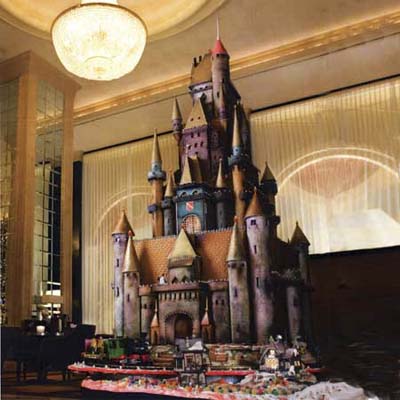With the holiday season comes the practice for some of creating a gingerbread house, an architectural feat that can be as amazing to view as it would be to eat the goodies that are used as construction materials.
Germany has a long and strong tradition of creating flat and shaped gingerbreads. The strong and flat gingerbread, Lebkuchen, are used to make gingerbread houses - also called Hexenhaeusle, which means "witches' houses," from the fairy tale Hansel and Gretel, or Lebkuchenhaeusel and Knusperhaeuschen, which means "houses for nibbling at".
Nuremberg, the "gingerbread capital" of the world, hosted Christkindlmarkt in December, a fair where Christmas decorations and seasonal foods were purchased. Gingerbread was not baked in homes but by a special guild of master bakers known as the Lebkuchler. Gingerbread bakers collaborated with sculptors, painters, and woodcarvers to create intricately designed and beautifully decorated gingerbread cakes. With these partnerships, it is easy to imagine how gingerbread houses were soon created.
During the nineteenth century, gingerbread was both modernised and romanticised. The practice of making gingerbread houses was brought by German immigrants to America where the practice grew and resulted in extraordinary creations. Elaborate Victorian houses and tiny one-room cottages were heavily decorated with candies and sugary creations and thus the tradition took off.
For inspiration in designing your own gingerbread house, here is more information on the Sugar Castle pictured above by chef Jean-Francois Houdre.
Source: Gingerbread House
 |
| The Sugar Castle, a gingerbread house, at the Westin St. Francis hotel in San Francisco |
Germany has a long and strong tradition of creating flat and shaped gingerbreads. The strong and flat gingerbread, Lebkuchen, are used to make gingerbread houses - also called Hexenhaeusle, which means "witches' houses," from the fairy tale Hansel and Gretel, or Lebkuchenhaeusel and Knusperhaeuschen, which means "houses for nibbling at".
Nuremberg, the "gingerbread capital" of the world, hosted Christkindlmarkt in December, a fair where Christmas decorations and seasonal foods were purchased. Gingerbread was not baked in homes but by a special guild of master bakers known as the Lebkuchler. Gingerbread bakers collaborated with sculptors, painters, and woodcarvers to create intricately designed and beautifully decorated gingerbread cakes. With these partnerships, it is easy to imagine how gingerbread houses were soon created.
During the nineteenth century, gingerbread was both modernised and romanticised. The practice of making gingerbread houses was brought by German immigrants to America where the practice grew and resulted in extraordinary creations. Elaborate Victorian houses and tiny one-room cottages were heavily decorated with candies and sugary creations and thus the tradition took off.
For inspiration in designing your own gingerbread house, here is more information on the Sugar Castle pictured above by chef Jean-Francois Houdre.
Source: Gingerbread House




